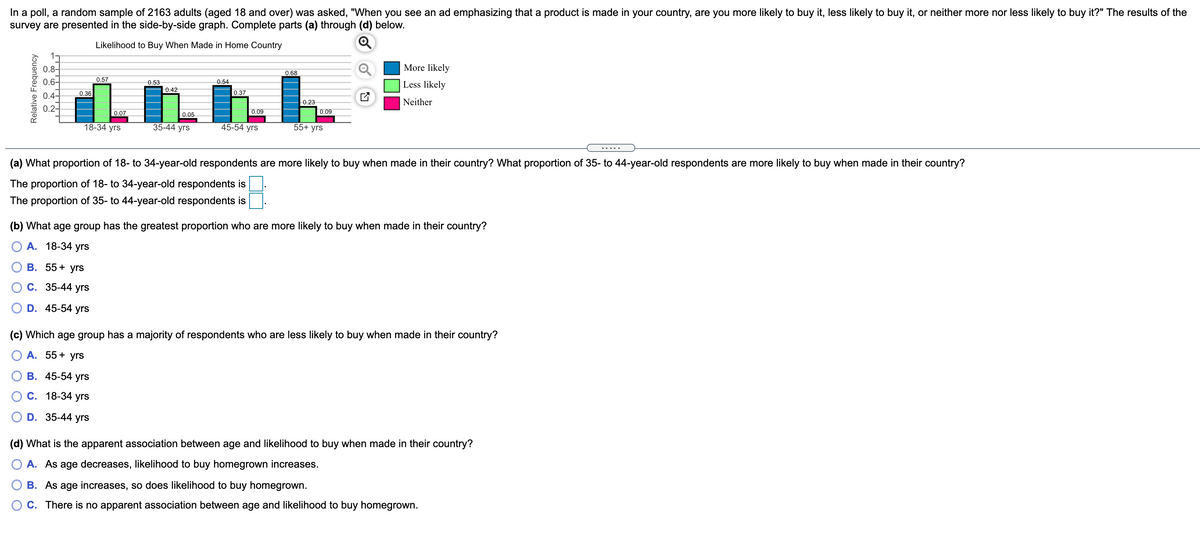In a poll, a random sample of 2163 adults (aged 18 and over) was asked, "When you see an ad emphasizing that a product is made in your country, are you more likely to buy it, less likely to buy it, or neither more nor less likely to buy it?" The results of the survey are presented in the side-by-side graph. Complete parts (a) through (d) below. Likelihood to Buy When Made in Home Country 0.8- 0.6 0.4- 0.2 More likely 0.57 053 0.54 OLess likely Neither 18-34 yrs 35-44 yrs 45-54 yrs 55+ yrs (a) What proportion of 18- to 34-year-old respondents are more likely to buy when made in their country? What proportion of 35- to 44-year-old respondents are more likely to buy when made in their country? The proportion of 18- to 34-year-old respondents is The proportion of 35- to 44-year-old respondents is (b) What age group has the greatest proportion who are more likely to buy when made their country? O A. 18-34 yrs O B. 55+ yrs О с. 35-44 уrs O D. 45-54 yrs (c) Which age group has a majority of respondents who are less likely to buy when made in their country? O A. 55+ yrs О в. 45-54 уrs OC. 18-34 yrs O D. 35-44 yrs
In a poll, a random sample of 2163 adults (aged 18 and over) was asked, "When you see an ad emphasizing that a product is made in your country, are you more likely to buy it, less likely to buy it, or neither more nor less likely to buy it?" The results of the survey are presented in the side-by-side graph. Complete parts (a) through (d) below. Likelihood to Buy When Made in Home Country 0.8- 0.6 0.4- 0.2 More likely 0.57 053 0.54 OLess likely Neither 18-34 yrs 35-44 yrs 45-54 yrs 55+ yrs (a) What proportion of 18- to 34-year-old respondents are more likely to buy when made in their country? What proportion of 35- to 44-year-old respondents are more likely to buy when made in their country? The proportion of 18- to 34-year-old respondents is The proportion of 35- to 44-year-old respondents is (b) What age group has the greatest proportion who are more likely to buy when made their country? O A. 18-34 yrs O B. 55+ yrs О с. 35-44 уrs O D. 45-54 yrs (c) Which age group has a majority of respondents who are less likely to buy when made in their country? O A. 55+ yrs О в. 45-54 уrs OC. 18-34 yrs O D. 35-44 yrs
Glencoe Algebra 1, Student Edition, 9780079039897, 0079039898, 2018
18th Edition
ISBN:9780079039897
Author:Carter
Publisher:Carter
Chapter10: Statistics
Section10.4: Distributions Of Data
Problem 19PFA
Related questions
Question

Transcribed Image Text:In a poll, a random sample of 2163 adults (aged 18 and over) was asked, "When you see an ad emphasizing that a product is made in your country, are you more likely to buy it, less likely to buy it, or neither more nor less likely to buy it?" The results of the
survey are presented in the side-by-side graph. Complete parts (a) through (d) below.
Likelihood to Buy When Made in Home OCountry
0.8-
More likely
0.68
0.57
0.6-
0.54
Less likely
0.53
0.42
0.36
0.37
0.4-
0.23
Neither
0.2-
0.07
0.09
0.09
0.05
18-34 yrs
35-44 yrs
45-54 yrs
55+ yrs
....
(a) What proportion of 18- to 34-year-old respondents are more likely to buy when made in their country? What proportion of 35- to 44-year-old respondents are more likely to buy when made in their country?
The proportion of 18- to 34-year-old respondents is
The proportion of 35- to 44-year-old respondents is
(b) What age group has the greatest proportion who are more likely to buy when made in their country?
О А. 18-34 yrs
О В. 55+ уrs
О С. 35-44 yrs
O D. 45-54 yrs
(c) Which age group has a majority of respondents who are less likely to buy when made in their country?
O A. 55+ yrs
О В. 45-54 yrs
О с. 18-34 yrs
O D. 35-44 yrs
(d) What is the apparent association between age and likelihood to buy when made in their country?
O A. As age decreases, likelihood to buy homegrown increases.
B. As age increases, so does likelihood to buy homegrown.
O C. There is no apparent association between age and likelihood to buy homegrown.
Relative Frequency
Expert Solution
This question has been solved!
Explore an expertly crafted, step-by-step solution for a thorough understanding of key concepts.
This is a popular solution!
Trending now
This is a popular solution!
Step by step
Solved in 2 steps

Recommended textbooks for you

Glencoe Algebra 1, Student Edition, 9780079039897…
Algebra
ISBN:
9780079039897
Author:
Carter
Publisher:
McGraw Hill


Glencoe Algebra 1, Student Edition, 9780079039897…
Algebra
ISBN:
9780079039897
Author:
Carter
Publisher:
McGraw Hill
